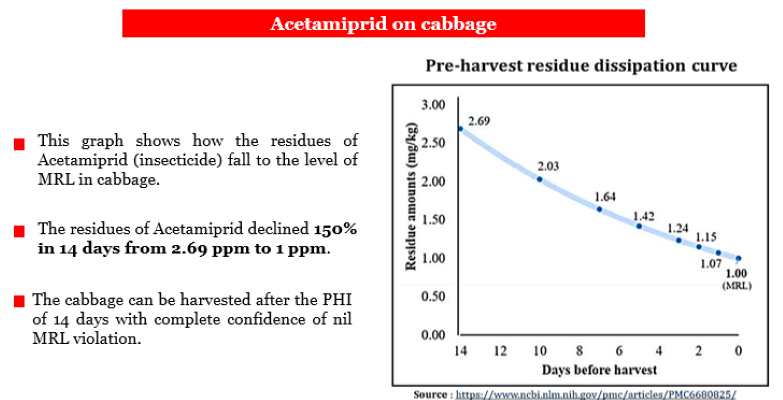The long pending crop grouping (first report came in 2015) for fixation of Maximum Residue Limits (MRLs) of pesticides in agricultural crop is yet to be implemented

Food Safety and Standards Authority of India (FSSAI) under the auspices of Ministry of Health and Family Welfare had organised “National Stakeholder Consultation on Challenges in Monitoring of pesticides Residue in Food Commodities” last week at Vigyan Bhawan, New Delhi.
Keeping in view the importance of the event Crop Care Federation of India (CCFI) presented Position Paper to Dr. Alka Rao, Advisor (Science and Standards and Regulations), National Codex – SPS Contact Point, FSSAI so as to raise certain issues affecting the pesticide industry.
Pesticides used in the agricultural farms under Insecticide Act, 1968
Section 38(1) (a) of the Insecticides Act, 1968 expressly states that nothing in the said Act would apply to the use of any insecticide by any person for his own land under cultivation. Its clear that neither insecticide Act nor FSS Act have any legal control over use of pesticides by any person for his own land under cultivation.
Concept on Pre-Harvest Interval (PHI)
In terms of Harvest, “PHI” stand for “Pre- Harvest Interval,” which refers to the minimum amount of time that must pass between the last application of a pesticide and when a crop can be harvest, ensuring that pesticide residue levels on the produce remain within safe limits before consumption essentially, it’s the waiting period after spraying before you can pick the crop.
Why PHI is important?
The PHI allows enough time for the pesticide concerned to breakdown in the plant without leaving residues beyond the Maximum Residue Level (MRL).
How does PHI gradually lead to decline in the pesticide residues?

If the farmers strictly follow the recommended uses of pesticides and comply with pre-harvest intervals (PHI), the possibilities of MRL violations and export rejections can be avoided. This will greatly benefit the growers, exporters and the agricultural trade.
Role of FSSAI
Definition of Crop Contaminant
Pesticide residues come under the term “Crop contaminant” as per Food Safety and Standards (Contaminants, Toxins and Residues) Regulations, 2011. According to this regulation “Crop contaminant” means any substance not intentionally added to food, but which gets added to articles of food in the process of their production (including operations carried out in crop husbandry, animal husbandry and veterinary medicine), manufacture, processing, preparation, treatment, packing, packaging transport or holding of articles of such food as a result of environmental contamination.
The definition clearly states that “Crop contaminant” [including pesticide residues] are substances that are not intentionally added to food.
Further, Section 18(3) of the FSS Act 2006 stipulates that the provisions of this Act shall not apply to any farmers or fisherman or farming operations or crops or livestock or aquaculture and supplies used or produced in farming or products of crop produced by a farmer at farm level or a fisherman in his operations.
A standing crop in the field pre or post-harvest cannot be termed as “food” within the ambit of FSS Act 2006. The food safety inspectors cannot take samples from the farmer’s field.
This means even the food safety inspectors cannot have any control over farmers or farming operation or products of crops produced by a farmer at farm level.
Policy paper suggested
Collective action by CIB&RC and FSSAI
• Many crops have no registered pesticides (or MRLs) in India: There are several crops for which there are no registered pesticides (or MRLs) are available. For example – Papaya, Pearl Millet (Ragi), Drumstick, Curry Leaves etc.
When there is pest attack on such crops what options are open to farmers? Are they expected to be deceased from using pesticides and suffer losses?
• The long pending crop grouping (first report came in 2015) for fixation of Maximum Residue Limits (MRLs) of pesticides in agricultural crop is yet to be implemented.
For action by FSSAI
Sanitary and Phytosanitary measures should be applicable to both domestic and Imported food/feed commodities
As per WTOs sanitary and Phytosanitary (SPS) Agreement, SPS (sanitary & phytosanitary) measures apply equally to domestic and imported food/feed products.
Countries like EU, USA etc. rejects exports from India alleging MRL violations. So, far there is no record about FSSAI rejecting any imported food/feed commodity on account of MRL violations involving pesticides/antibiotics.
MRLs Monitoring for pesticides/antibiotics cannot be limited to domestic food/feed commodities.
During interactive session CCFI highlighted the need to popularize the concept of PHI among relevant stakeholders. The meeting was attended by Dr. J C Majumdar, Chief Scientific Advisor, and Harish Mehta, Senior Advisor, CCFI.
Subscribe to our newsletter & stay updated.